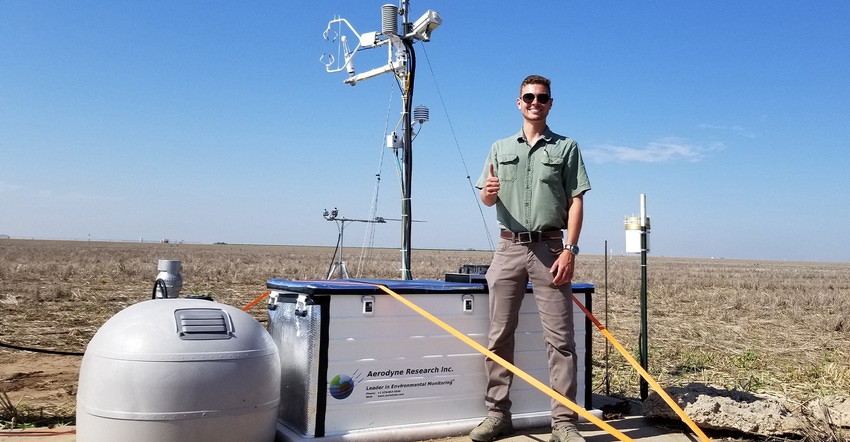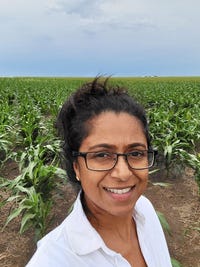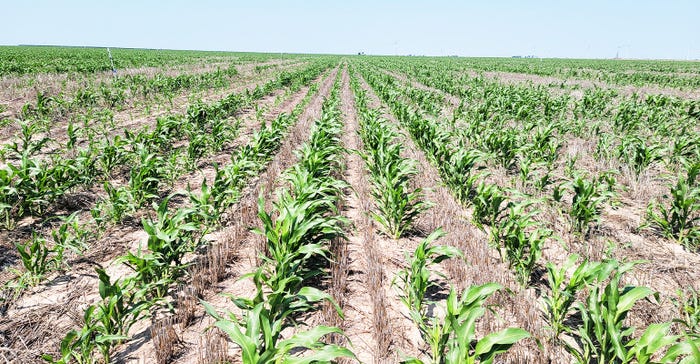
Nitrous oxide has been tagged the most significant ozone destroying compound of the 21st Century, and agriculture is the largest emitter, accounting for 74% of emissions.
“We have to pay nitrous oxide more attention,” says Nithya Rajan, associate professor, department of soil and crop sciences, Texas A&M University, College Station.
 Nithya Rajan, associate professor, department of soil and crop sciences, Texas A&M University, College Station. (Photos by Nithya Rajan)
Nithya Rajan, associate professor, department of soil and crop sciences, Texas A&M University, College Station. (Photos by Nithya Rajan)
Rajan, speaking at the recent Texas Plant Protection Association annual conference in Bryan, said Texas AgriLife research projects seek better methods of measuring greenhouse gas emissions and better farming practices to reduce those emissions.
“Carbon farming is gaining significant momentum in the U.S. and other countries as a major strategy for achieving carbon neutrality or ‘net zero’ emissions,” she said.
To take advantage of that potential market, we need to develop methods to accurately measure greenhouse gas emissions and revise cropping system practices to capture carbon.
“Accurately measuring greenhouse gas emissions requires high frequency emission monitoring and state-of-the-art research instrumentation to generate necessary data,” Rajan said.
“The current U.S. Federal Government is keen to establish a ‘carbon bank;’ however, we lack a mechanism to document the actual emission reductions from agricultural fields implementing carbon farming practices.
Time and space
“It is important to account for temporal and spatial detail for all major greenhouse gas fluxes (carbon dioxide, nitrous oxide, and methane) to properly estimate carbon offsets,” she said.
 SMARTFARM project site (sorghum-winter wheat, reduced tillage)
SMARTFARM project site (sorghum-winter wheat, reduced tillage)
She explained that an ongoing project funded by the Department of Energy’s Systems for Monitoring and Analytics for Renewable Transportation Fuels from Agricultural Resources and Management (SMARTFARM) initiative, AgriLife researchers are collecting continuous GHG emission data from a 90-acre reduced-till sorghum field in the Texas High Plains. This field belongs to Kevin Pshigoda, a fourth-generation farmer in Perryton, Texas.
Research goals
Objectives of the research include developing monitoring technologies to quantify GHG emissions due to biofuel feedstock production. The project also will determine carbon intensity (CI) associated with sorghum production. The team has set up instrumentation to continuously measure all three major greenhouse gases from grain sorghum in the Southern Great Plains.
The SMARTFARM project is also examining the advantages of sorghum for ethanol production. Sorghum is primarily dryland, much more drought tolerant than corn, and produces the same ethanol per bushel as corn (2.5 to 3 gallons).
Sorghum is also a limited input crop and averages about 70 to 80 bushels per acre.
Carbon sink
Research from the SMARTFARM research indicated that the sorghum-no till field was a net carbon sink. Also, nitrous oxide emissions were significantly low (no fertilizer was applied).
Although nitrous oxide emission was low in the field that was investigated, that may not be case in fertilized fields. “We need to reduce those emissions,” Rajan said. “An increase in nitrous oxide emission will substantially increase carbon intensity associated with cropping practices and can counteract the benefits associated with soil carbon capture.”
“Climate-smart farming strategies have the potential to decrease carbon intensity and increase opportunities for market incentives.”
About the Author(s)
You May Also Like






